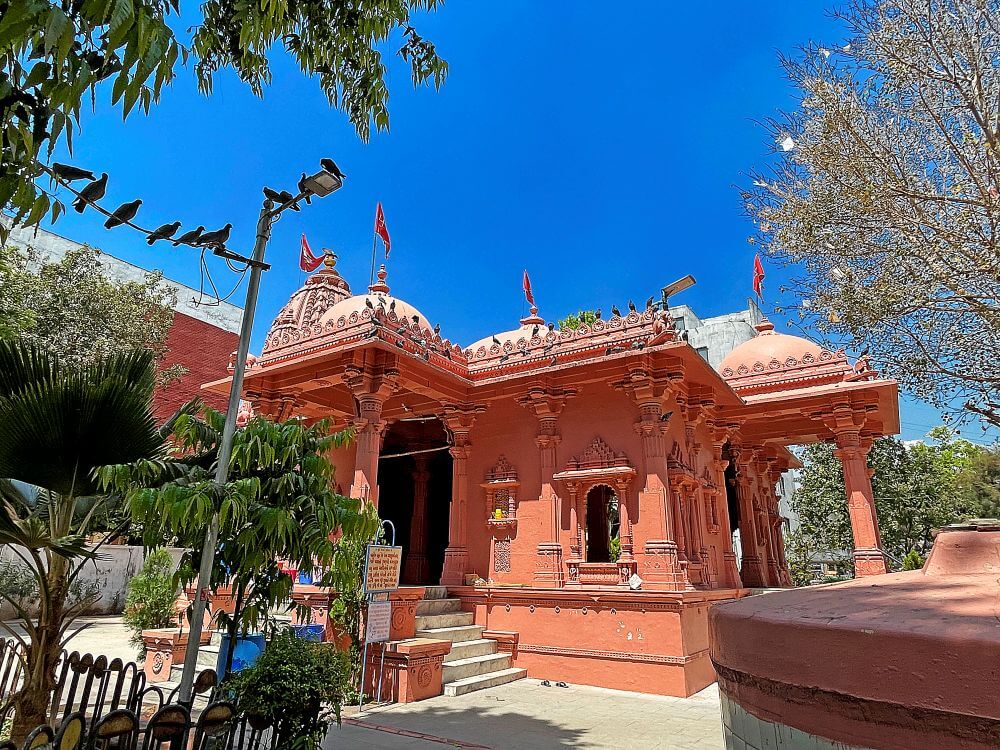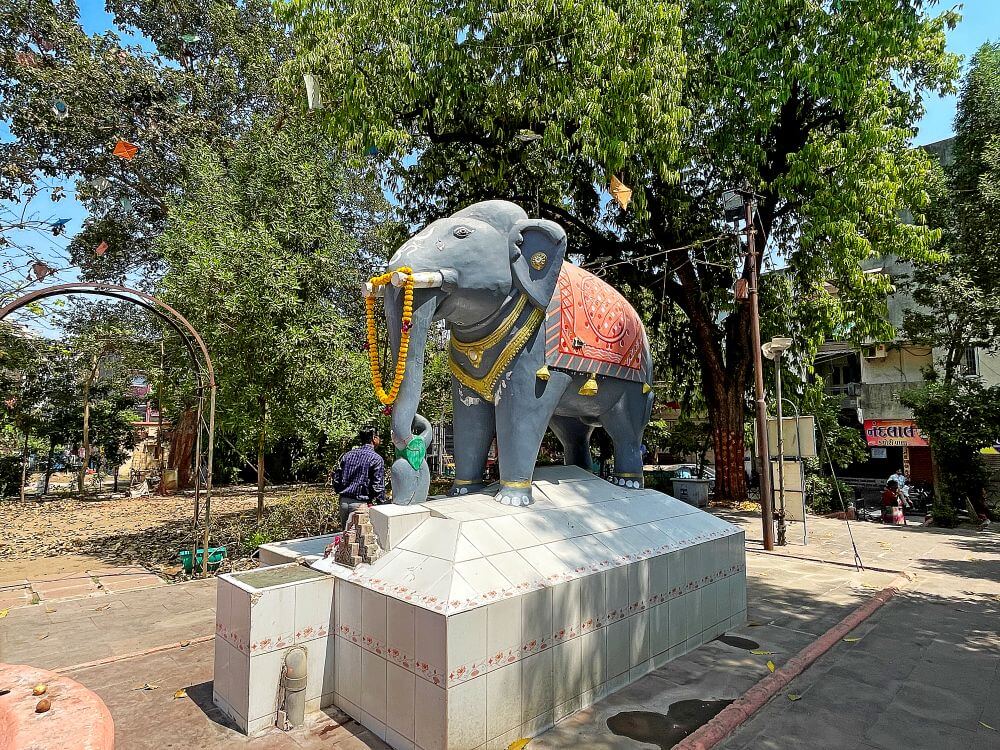

Across the world, many ancient monuments have been built in memory of loved ones. However, in the historic city of Vadodara, there is a unique temple built not in memory, but at the insistence of a beloved devotee. That temple is the Suryanarayan Temple, located in Raopura. Built in the 18th century in Nagar architectural style, it is an excellent example of ancient Indian temple architecture. A special feature of the temple is that sunrays enter the sanctum at sunrise every day.
During the reign of Govindrao and Anandrao Gaekwad, between 1793 and 1803, Raoji Appaji Phanse served as Diwan (Prime Minister) of Baroda State. He had been sent from Pune by Nana Fadnavis. As noted in ‘Shindeshahi Itihasachi Sadhane, Part 4, Wakankar Collection’, Raoji Appaji governed Baroda effectively, albeit with British influence. He passed away in 1803, but before that, he had this temple constructed. The area where the temple stands was formerly known as Sadashiv Peth and due to Raoji Appaji’s prominence, it came to be known as Raopura.
It is said that Raoji Appaji once visited Kashi on pilgrimage.  While performing rituals at the Manikarnika Ghat, he saw a beautiful married woman named Gulbadan, a Vaishnavite from Rajasthan. Struck by her beauty, Raoji fell in love. Over time, Gulbadan also fell for him, but being married, their union was forbidden by social norms. Despite this, Raoji had her divorced from her husband and married her, defying the societal taboos of that era.
While performing rituals at the Manikarnika Ghat, he saw a beautiful married woman named Gulbadan, a Vaishnavite from Rajasthan. Struck by her beauty, Raoji fell in love. Over time, Gulbadan also fell for him, but being married, their union was forbidden by social norms. Despite this, Raoji had her divorced from her husband and married her, defying the societal taboos of that era.
Around this time, conflict broke out in Baroda’s royal family. According to historian Govind Sakharam Sardesai in ‘Marathi Riyasat – Uttar Vibhag, Volume 3’, succession disputes erupted after Govindrao Gaekwad’s death. Raoji Appaji’s Arab troops rebelled against him, prompting him to seek help from the British, which led to their entry into Baroda’s politics. Amidst these events, he had little time for Gulbadan, who became upset.  To appease her, Raoji promised, “I will do whatever you wish.” Despite being a Vaishnavite, Gulbadan was a devout worshipper of Surya (Sun God) and requested a temple to be built for Suryanarayan. Raoji immediately ordered its construction.
To appease her, Raoji promised, “I will do whatever you wish.” Despite being a Vaishnavite, Gulbadan was a devout worshipper of Surya (Sun God) and requested a temple to be built for Suryanarayan. Raoji immediately ordered its construction.
The temple was built swiftly and a statue of Suryanarayan was prepared. However, when Raoji brought Gulbadan to see the temple before consecration, she said, “The Sun always rises in the east and sets in the west. If the idol faces east, its gaze will fall upon the city, which is inauspicious.” Concerned, Raoji consulted scholars who confirmed that a direct gaze of the Sun deity upon a city is believed to bring destruction. One Brahmin suggested placing a sculpture of Airavat (the celestial elephant of Indra) in front of the temple.  This would block the first rays of the sun and neutralize the inauspicious effect. A massive elephant sculpture from a nearby hilltop stupa was brought and placed in front of the temple. Only then was the idol of Suryanarayan ceremoniously consecrated.
This would block the first rays of the sun and neutralize the inauspicious effect. A massive elephant sculpture from a nearby hilltop stupa was brought and placed in front of the temple. Only then was the idol of Suryanarayan ceremoniously consecrated.
The temple is located opposite the Raopura Post Office. It stands on a raised platform with six steps leading to a large courtyard. Upon entry, one sees the giant sculpture of Airavat and beside its front leg is a small ancient Shivling, along with an idol of the Naga (serpent deity). Nearby is a large circular fountain.
A short distance from there, the main temple stands on a high plinth made of red Rajasthani stone. It consists of  sabhamandap (assembly hall), three surrounding mandaps for darshan (viewing), antaral (intermediate chamber) and garbhagriha (sanctum sanctorum). The darshan mandaps and sabhamandap have dome-shaped spires, while the garbhagriha features a tall Urushringa-style spire in Nagar architecture, topped with a two-tiered amalaka and a high kalash (pinnacle). Small elephant sculptures, symbols of prosperity, adorn the roof corners.
sabhamandap (assembly hall), three surrounding mandaps for darshan (viewing), antaral (intermediate chamber) and garbhagriha (sanctum sanctorum). The darshan mandaps and sabhamandap have dome-shaped spires, while the garbhagriha features a tall Urushringa-style spire in Nagar architecture, topped with a two-tiered amalaka and a high kalash (pinnacle). Small elephant sculptures, symbols of prosperity, adorn the roof corners.
Seven symbolic steps (for the seven days of the week) lead into the temple. The pillars of the sabhamandap are intricately carved and feature figures of celestial maidens (surasundaris). Numerous windows and ventilated panels allow natural light inside.
 Inside the sanctum, there is a marble idol of Suryanarayan, riding a chariot drawn by seven horses, representing the seven days of the week. On either side of the Sun God are the idols of Sanjna and Chhaya, his consorts.
Inside the sanctum, there is a marble idol of Suryanarayan, riding a chariot drawn by seven horses, representing the seven days of the week. On either side of the Sun God are the idols of Sanjna and Chhaya, his consorts.
At this ancient temple, devotees can have darshan of Suryanarayan from 7 AM to 7 PM. Aarti is performed both in the morning and evening. It is believed that worshipping the Sun God cures illnesses and removes sorrows from life, which is why hundreds of devotees visit the temple daily.
A grand celebration is held here on Rath Saptami, which falls in the Hindu month of Magh. On this day, the temple is beautifully decorated with flowers and lamps, and the idol of Suryanarayan is also adorned with flowers. Various religious rituals, including a Lakshmi Havan, are performed. Devotees begin gathering at the temple from early morning to seek the blessings of the Sun God.



